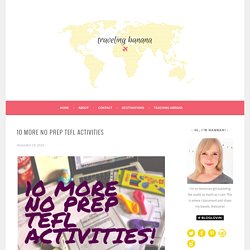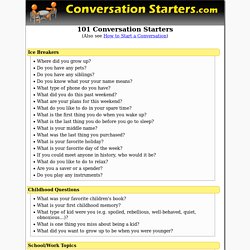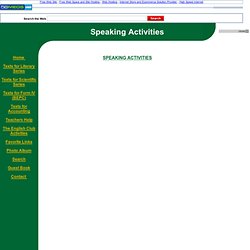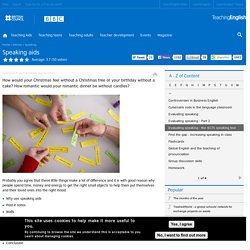

Motivating speaking activities for lower levels. Planning time has been shown to increase production in speaking tasks. Lower level learners often find it especially difficult to speak spontaneously, so these activities incorporate 'thinking time' during which learners can prepare for speaking by planning what they are going to say, and asking the teacher or using a dictionary to look up missing vocabulary.
The following activities are relatively short, with minimal materials preparation time for the teacher. They are designed for use as a warmer or a filler in the middle or at the end of a class. 1. Definitions lists This activity is good for activating existing vocabulary or revising vocabulary studied in previous lessons. Procedure Choose a vocabulary topic (this can be vocabulary you have recently studied or a topic you want to introduce). A faster-moving, fun alternative to this activity is a team game. 2. 3. SPEAKING. Free English Listening Comprehension and Speaking exercises. ESL Dialogues. 10 Intriguing Photographs to Teach Close Reading and Visual Thinking Skills. Photo Updated, March 17, 2016 | We have published a companion piece: “8 Compelling Mini-Documentaries to Teach Close Reading and Critical Thinking Skills.”

Ever want your students to slow down and notice details when they read — whether they’re perusing a book, a poem, a map or a political cartoon? Young people often want to hurry up and make meaning via a quick skim or a cursory glance when a text can demand patience and focus. Closely reading any text, whether written or visual, requires that students proceed more slowly and methodically, noticing details, making connections and asking questions. This takes practice. We’ve selected 10 photos from The Times that we’ve used previously in our weekly “What’s Going On in This Picture?” Below, we offer ideas from students and teachers who have engaged with these images for ways to use them, or images like them, to teach close reading and visual thinking skills. 1. I stumbled across your site while looking for alternate ideas. 2. 3. 4. 5. 6. 10 MORE NO PREP TEFL Activities - Traveling Banana. Wow!

Thanks for all the love everybody! What’s Going On in This Picture - The Learning Network Blog - The New York Times. Photo Students 1.

After looking closely at the image above (or at the full-size image), think about these three questions: Picture description. Describing photos (comparing, contrasting and speculating) You are going to practise language for; Describing photosComparing and contrasting photos (discussing similarities and differences)Speculating on what might be happeningReacting to photos (giving opinions) Discuss Look at the presentation.

Follow the instructions and talk about some of the photos Write The language used here for comparing and contrasting / speculating is also useful for writing discussion / argument essays. Plan: Introduction - describe the situation / topic to be discussedCompare / contrast ideas (for and against / advantages and disadvantages)Speculate on solutions to problems raised by the questionConclusion - give an opinion Which pairs or groups of photos in the presentation could be used to demonstrate ideas for argument writing topics about education, technology, food, family, work, leisure, health, advertising etc? 101 Conversation Starters. (Also see How to Start a Conversation) Ice Breakers.

Debates, discussion & speaking activity lessons for esl teachers: eslflow webguide. Presentation Tools Online. Simple shopping. Conversation Questions for the ESL/EFL Classroom. If this is your first time here, then read the Teacher's Guide to Using These PagesIf you can think of a good question for any list, please send it to us. Home | Articles | Lessons | Techniques | Questions | Games | Jokes | Things for Teachers | Links | Activities for ESL Students Would you like to help?
If you can think of a good question for any list, please send it to us. If you would like to suggest another topic, please send it and a set of questions to begin the topic. Copyright © 1997-2010 by The Internet TESL Journal Pages from this site should not be put online elsewhere.Permission is not required to link directly to any page on our site as long as you do not trap the page inside a frame. ESL Discussions: English Conversation Questions / Debates: Speaking Lesson Activities.
Asking and giving directions. Speaking Activities. On these pages you will find ideas for classsroom activities which involve speaking.

(These tips are taken on this site · Find the murderer · Bingo mingle. ESL Discussions: English Conversation Questions / Debates: Speaking Lesson Activities. The EFL SMARTblog: Describing photos (comparing, contrasting and speculating) Taboo questions. Mobile. How to Come Up with Good Conversation Topics (with Sample Topics) Expert Reviewed Four Parts:Learning About Basic Conversation StartersExtending the ConversationPushing BoundariesConversation HelpCommunity Q&A Even if you're good with people, there are likely times when you're stuck for something more to say and start wondering what topic to bring up next.

To come up with good conversation topics, you should prepare a mental list of ideas beforehand so that you can seamlessly pull up one idea and continue on with your chat. Form conversation around the other person, tailoring the topic based on how well you know him or her, and give the other person equal opportunity to steer the conversation in other directions. Steps Part 1 Learning About Basic Conversation Starters <img alt="Image titled Come Up with Good Conversation Topics Step 1" src=" width="728" height="546" class="whcdn" onload="WH.performance.clearMarks('image1_rendered'); WH.performance.mark('image1_rendered');">1Talk about the other person. Part 2 Extending the Conversation Part 3 Community Q&A. Ethical Dilemmas Archive. #1: Jeff's best friend is getting into some pretty risky behaviors, including dangerous drugs.

What can Jeff do to help his friend? #2: Jennifer knows her parents won't let her go to "the big party" if they find out the host's parents are out of town. Should she lie about it? #3: What's the difference between cheating on a math test and lying about your age in order to save money on a movie ticket? #4: Julia's best friend has turned against her and is now organizing the other girls to bully and isolate her.
Language In Use. It is great to show and offer students many examples of English language in use.

Meaning, students appreciate that there are many ways to say the same thing and like to see the "nuance" of the English language. Here are some images showing different ways / expressions to communicate a similar thing. Might be handy. Discussion-game.pdf. Dont_say_the_words_3. Speaking aids. Probably you agree that these little things make a lot of difference and it is with good reason why people spend time, money and energy to get the right small objects to help them put themselves and their loved ones into the right mood.

Why use speaking aids Post-it notes Walls Coloured paper Small objects To control turn-taking As metaphors Conclusion Why use speaking aids In contrast, we often expect that our students have the right mood to speak without having anything that would help them to be in the right mood to speak, or any prompt that would help the flow of ideas. These small prompts or small speaking aids get especially important when children get into the age when they want to speak about themselves more than e.g. about the little animals or fairies in a tale.